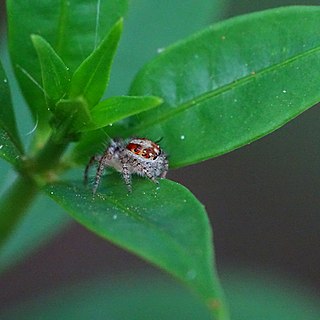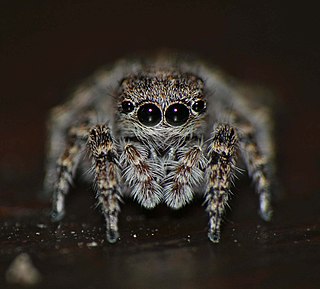
Anelosimus is a cosmopolitan genus of cobweb spiders (Theridiidae), currently containing 74 species. Anelosimus is a key group in the study of sociality and its evolution in spiders. It contains species spanning the spectrum from solitary to highly social (quasisocial), with eight quasisocial species, far more than any other spider genus. Among these is the South American social species Anelosimus eximius, among the best studied social spider species.

Rugathodes sexpunctatus is a minute species of spider in the family Theridiidae, the cobweb or tangle-web spiders. This family includes the medically important genus Latrodectus—the widow spiders. The species in the genus Rugathodes are too small to be dangerous to humans. Very little is known about most species in this genus.
Garcorops jadis is a possibly extinct species of Wall crab spider, family Selenopidae, and at present, it is one of four known species in the genus Garcorops. The species is solely known from copal found on the beach near Sambava, on the northeast coast of Madagascar.
Pimoa cthulhu is a species of the spider family Pimoidae. It is one of twenty-one described species in the genus Pimoa.
Anelosimus biglebowski is a species of spider in the family Theridiidae. All specimens known have been found in the Udzungwa Scarp Forest Reserve, Mufindi District, Tanzania. It is named for the 1998 film The Big Lebowski.
Anelosimus dude is a species of spider in the family Theridiidae. It is native to Tanzania, having only been found in the Udzungwa Scarp Forest Reserve and Mazumbai Forest Reserve. It is closely related to Anelosimus biglebowski. The name A. dude derives from "The Dude", a character in the 1998 film The Big Lebowski.
Anelosimus monskenyensis is a small species of spider in the family Theridiidae. It has only been found on Mount Kenya, the location from which its name originates. Males range in size from 1.80 to 1.90 millimetres, while females range from 1.90 to 2.55 millimetres. Specimens were shades of brown and white, although color variation is not known. They may kleptoparasitically inhabit the webs of agelenid spiders, although this behavior is not found in other Anelosimus species. Agnarsson and Zhang find it more probable that A. monskenyensis is a social or semi-social spider.
Anelosimus sulawesi is a small species of spiders in the family Theridiidae. It is known only from Dumoga Bone National Park, Sulawesi, Indonesia. The name derives from the location it was discovered. The holotype male is 2.00 millimetres (0.079 in) total length, while a female of the same species was measured to be 2.05 millimetres (0.081 in). The coloration is brown with some white on the dorsal folium, similar to other species in Anelosimus.
Anelosimus nelsoni is a species of spider in the family Theridiidae. It is only known from iSimangaliso Wetland Park, KwaZulu-Natal, South Africa. It is named for Nelson Mandela. The male holotype specimen is 2.08 millimetres (0.082 in) in length, and the female paratype is 2.60 millimetres (0.102 in) in length. Both the holotype and paratype were found on Fanies Island, 5 km south of Cape Vidal. Both were collected from bushes or trees in an open forest patch.
Anelosimus agnar is a species of spider in the family Theridiidae. The holotype and paratype specimens were collected in Teluk Mahkota, Johor, Malaysia. Both specimens are female; this species currently lack information on males. The spider is named for Agnar Ingólfsson, the father of the discoverer, Ingi Agnarsson. Females can be identified as members of this species by unusually long and flimsy copulatory ducts. Females range in size from 2.05 to 2.40 millimetres. Both the holotype and paratype were collected from small webs at the tips of branches, from a forested area next to a beach.
Anelosimus linda is a species of spider in the family Theridiidae. The holotype and paratype specimens were collected in Cameron Highlands, Pahang, Malaysia. Both specimens are female; this species currently lack information on males. The spider is named for Linda Wendel, the mother of the discoverer, Ingi Agnarsson. Females are approximately 1.90 millimetres (0.075 in). A. linda lives in mid-elevation forest; both the holotype and paratype were collected at 1550m elevation.
Anelosimus oritoyacu is a species of tangle-web spider found in Ecuador and Mexico at altitudes from 1,800 to 2,000 metres. It is subsocial, although it has some features which distinguish it from other social or subsocial spiders in the genus. It has long-lived nest sites, unlike the social spider Anelosimus eximius which has more transitory nest sites, and its webs do not have aerial threads found in other social and sub-social species. It has a female-biased sex ratio, which is indicative of social behavior, although its sex ratio is smaller than other social species. It was first identified as distinct from Anelosimus studiosus in 2006 by Ingi Agnarsson. It is named for Oritoyacu, Ecuador, where the type specimen was collected.
Anelosimus terraincognita is a species of spider discovered in the collection of the Rijksmuseum van Natuurlijke Historie, with no associated information as to its collector or location of discovery. Males have a corkscrew-shaped embolus, which is a characteristic unique to Australasian species within the genus Anelosimus. It is known only from the holotype specimen, which has a total length of 2.2 millimetres (0.087 in). It is named for the cartographic Latin phrase terra incognita, meaning unknown land.
Anelosimus pomio is a species of tangle-web spider found in Papua New Guinea. It was first collected in 2009 by Ingi Agnarsson, and identified by the same in 2012. It was collected from small-leaved mangrove trees adjoining a beach. It is 3 to 4 millimetres in length, and can be distinguished from other species in its genus by the shape of the embolus. The embolus looks similar to that of Anelosimus chonganicus and Anelosimus membranaceus: It forms a corkscrew shape with fewer turns than A. chongnicus and the turns are closer to the base than A. membranaceus. It is presumed to be a solitary spider, although there are limited data. Its name is derived from the village of Pomio, in East New Britain Province, near where it was collected.
Anelosimus bali is a species of spider found in Bali, Indonesia, after which the species is named. It is a coastal species, found in small-leaved mangrove trees along the beach. The holotype is female and 2.9 millimetres (0.11 in) long. No male specimens have been identified, and the social structure of the species is not known. It was first identified in 2012 by Ingi Agnarsson.
Anelosimus pratchetti is a species of tangle-web spider found in New South Wales, Australia. Initial field observations indicate it is a subsocial spider. It lives in low elevation environments, including beachfront mangrove forests. It was identified by Ingi Agnarsson in 2012, who named the species after Terry Pratchett, whom Agnarsson described as "a comic genius".

Hyllus ramadanii is a species of jumping spider in the genus Hyllus that is endemic to Tanzania. It lives in rocky environments. The spider was first described in 2000 by Wanda Wesołowska and Anthony Russell-Smith. The spider is medium-sized, with a brown carapace between 3.1 and 3.2 mm long and an abdomen 3.2 and 5.0 mm long. The female is larger than the male. It can be differentiated from other species in the genus by its coloration and copulatory organs. The male has a pattern of three white patches on its carapace and a horseshoe shape on its abdomen. The female has three irregular orange streaks on its carapace and a yellow pattern that looks like a tree on its abdomen.

Langelurillus manifestus is a species of jumping spider in the genus Langelurillus that lives in Tanzania. It was first described in 2000 by Wanda Wesołowska and Anthony Russell-Smith. The spider is small, with a carapace that is between 2.1 and 2.5 mm long and an abdomen between 2.0 and 2.2 mm long. The female carapace is lighter than the male and has a pattern of irregular patches, which may also be found in some examples of the female abdomen. The male abdomen is lighter and has a fawn streak down the middle. The legs are brown, the female having dark rings on its legs. It is similar to other related species, particularly Langelurillus rufus, but can be distinguished by the male's larger size and lighter coloration. The female has an oval epigyne that leads to seminal ducts that are shorter than Langelurillus rufus but longer than Langelurillus squamiger.

Langelurillus quadrimaculatus is a species of jumping spider in the genus Langelurillus that lives in Nigeria. It was first described in 2011 by Wanda Wesołowska and Anthony Russell-Smith. The spider is small, with a cephalothorax that is between 1.7 and 2.5 mm long and an abdomen between 2.0 and 2.2 mm long. The female is larger than the male. It can be distinguished from other species in the genus by its abdominal pattern, which is recalled in the species name, that consists of two pairs of rounded yellow patches on a brownish-grey background. The female also has a distinctive internal layout of its seminal ducts within its short and wide epigyne.
Dipoena santacatarinae is a species of araneomorphae spider in the family Theridiidae.




